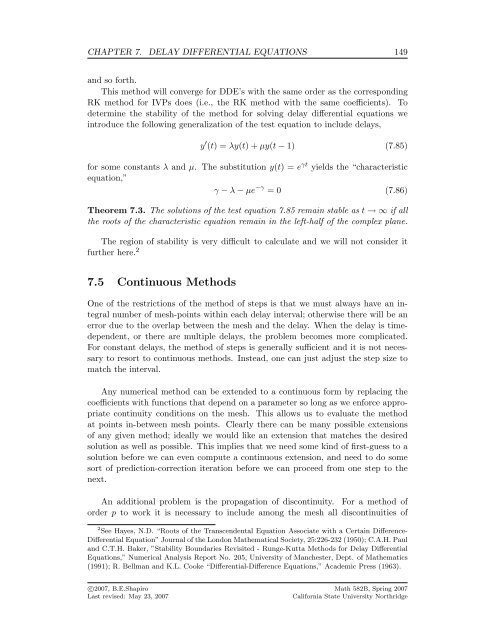The Computable Differential Equation Lecture ... - Bruce E. Shapiro
The Computable Differential Equation Lecture ... - Bruce E. Shapiro
The Computable Differential Equation Lecture ... - Bruce E. Shapiro
Create successful ePaper yourself
Turn your PDF publications into a flip-book with our unique Google optimized e-Paper software.
CHAPTER 7. DELAY DIFFERENTIAL EQUATIONS 149<br />
and so forth.<br />
This method will converge for DDE’s with the same order as the corresponding<br />
RK method for IVPs does (i.e., the RK method with the same coefficients). To<br />
determine the stability of the method for solving delay differential equations we<br />
introduce the following generalization of the test equation to include delays,<br />
y ′ (t) = λy(t) + µy(t − 1) (7.85)<br />
for some constants λ and µ. <strong>The</strong> substitution y(t) = e γt yields the “characteristic<br />
equation,”<br />
γ − λ − µe −γ = 0 (7.86)<br />
<strong>The</strong>orem 7.3. <strong>The</strong> solutions of the test equation 7.85 remain stable as t → ∞ if all<br />
the roots of the characteristic equation remain in the left-half of the complex plane.<br />
<strong>The</strong> region of stability is very difficult to calculate and we will not consider it<br />
further here. 2<br />
7.5 Continuous Methods<br />
One of the restrictions of the method of steps is that we must always have an integral<br />
number of mesh-points within each delay interval; otherwise there will be an<br />
error due to the overlap between the mesh and the delay. When the delay is timedependent,<br />
or there are multiple delays, the problem becomes more complicated.<br />
For constant delays, the method of steps is generally sufficient and it is not necessary<br />
to resort to continuous methods. Instead, one can just adjust the step size to<br />
match the interval.<br />
Any numerical method can be extended to a continuous form by replacing the<br />
coefficients with functions that depend on a parameter so long as we enforce appropriate<br />
continuity conditions on the mesh. This allows us to evaluate the method<br />
at points in-between mesh points. Clearly there can be many possible extensions<br />
of any given method; ideally we would like an extension that matches the desired<br />
solution as well as possible. This implies that we need some kind of first-guess to a<br />
solution before we can even compute a continuous extension, and need to do some<br />
sort of prediction-correction iteration before we can proceed from one step to the<br />
next.<br />
An additional problem is the propagation of discontinuity. For a method of<br />
order p to work it is necessary to include among the mesh all discontinuities of<br />
2 See Hayes, N.D. “Roots of the Transcendental <strong>Equation</strong> Associate with a Certain Difference-<br />
<strong>Differential</strong> <strong>Equation</strong>” Journal of the London Mathematical Society, 25:226-232 (1950); C.A.H. Paul<br />
and C.T.H. Baker, ”Stability Boundaries Revisited - Runge-Kutta Methods for Delay <strong>Differential</strong><br />
<strong>Equation</strong>s,” Numerical Analysis Report No. 205, University of Manchester, Dept. of Mathematics<br />
(1991); R. Bellman and K.L. Cooke “<strong>Differential</strong>-Difference <strong>Equation</strong>s,” Academic Press (1963).<br />
c○2007, B.E.<strong>Shapiro</strong><br />
Last revised: May 23, 2007<br />
Math 582B, Spring 2007<br />
California State University Northridge
















